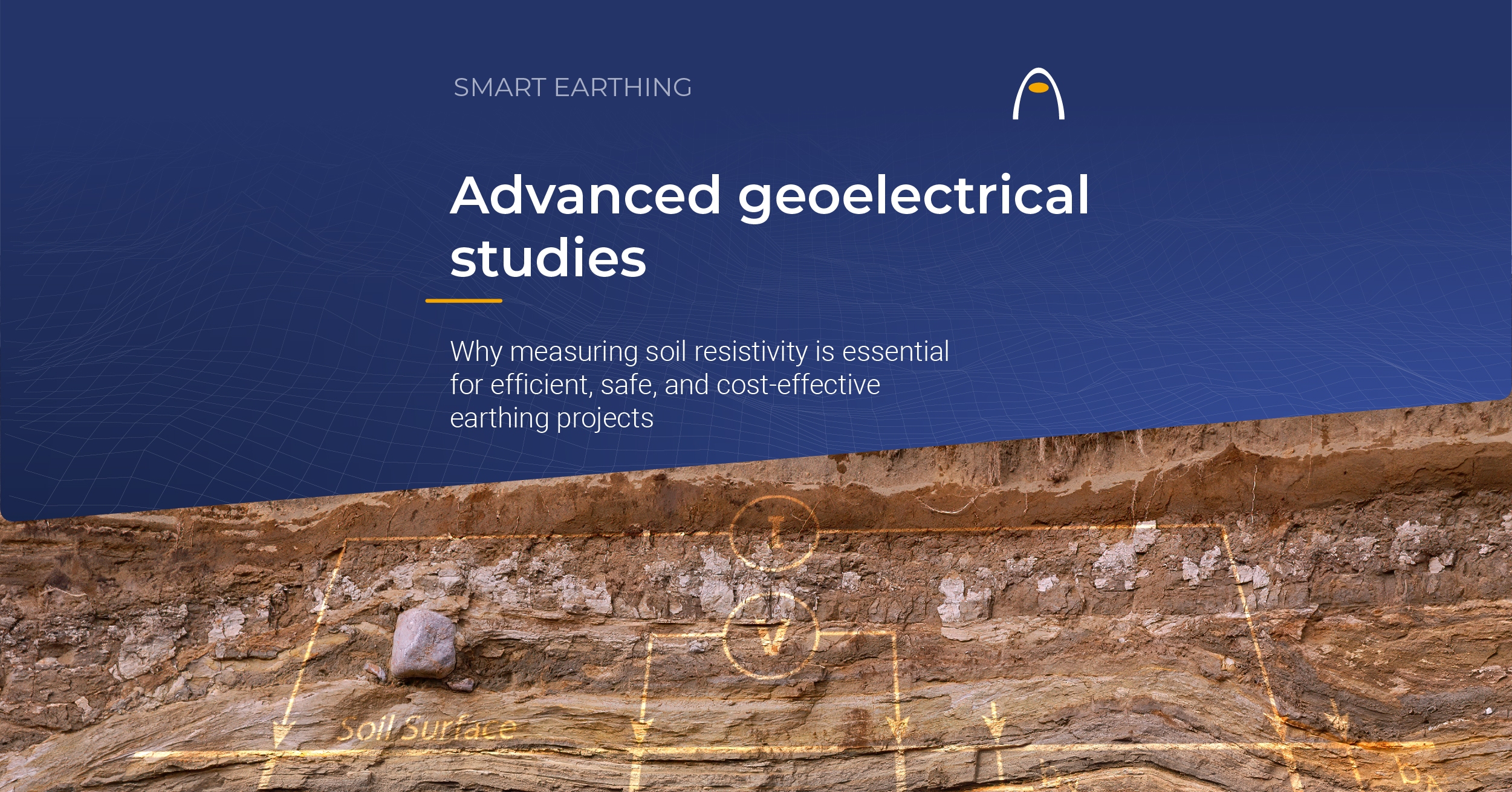The geoelectrical study of the subsoil makes it possible to establish the optimum configuration of the earthing system to be designed. The ground resistivity measurement makes it possible to determine the layout, depth, number and type of elements necessary according to safety and functional requirements.
The resistivity of the soil is a characteristic that defines the opposition of the soil to the passage of electricity, also known as the specific resistance of the soil. The subsoil is usually stratified in layers and unknown resistivities, which determine the resistance value of an earthing system. The objective of geoelectrical studies is the electrical characterisation of the subsoil by determining the number of layers, their thickness and the resistivity of each one.
The measurement of resistivity makes it possible to estimate the earthing resistance of a structure or a system and the potential gradients including step and touch voltages. It also helps in the calculation of inductive coupling between neighbouring power and communication circuits, as well as the design of cathodic protection systems.
The resistivity of the ground determines the design parameters of an earthing system, such as the optimum burial depth; the appropriate materials according to the corrosion rate in the ground; the number, type and appropriate arrangement of electrodes required. In this way, the desired resistance value and the highest safety of the system are obtained.
With the electrical characteristics of an earthing system, it is possible to design a more efficient earthing system, quicker to execute, with lower design costs, controlled step and touch voltages over the entire surface, greater safety for people in the installation, and with an optimised service life.
Why soil resistivity is crucial in an earthing project
Soils are not homogeneous, so variations in resistivity occur. The main factors for these variations are soil type, amount of moisture, chemical composition, material compaction, temperature, soil stratification, mixture of different materials, concentration and chemical composition of dissolved salts, particle size, etc.
Some of these aspects depend on long-term changes and can be assumed as constants in the earthing system project (soil type, chemical composition, stratification and compaction of the material). However, others (moisture content, temperature, concentration and chemical composition of dissolved salts) are variable.
In resistivity measuring, the effects of the different soil layers are averaged to obtain the so-called apparent resistivity. There are various methods of measuring resistivity. Two of the most commonly used are presented below: the Wenner and the Schlumberger1 configurations.
Wenner’s method for soil resistivity measuring
The Wenner method, developed by Frank Wenner of the US Bureau of Standards in 19162, is the most commonly used method for measuring soil resistivity. It consists of using four spikes, spaced at equal distances from each other. The two inner ones are the potential electrodes, while the outer ones are the current electrodes. By measuring the potential difference between the inner electrodes and dividing by the current electrodes, the resistance is obtained.
By taking different measurements and changing the spacing of the electrodes, different values are obtained which, plotted as a function of distance, indicate the different layers that make up the soil under study.
This method makes it possible to obtain the soil resistivity for deep layers, without burying the electrodes at these depths. In addition, the results are not affected by the resistance of the auxiliary electrodes or the holes created to drive them into the ground.
The interpretation of the resistance values measured in the ground is more straightforward in terms of apparent resistivity, making it possible to visualise the trend of this parameter easily.
Finally, the instruments may be less sensitive than those required for the Schlumberger configuration, as when the current electrodes are separated, the potential electrodes are also distanced.
Schlumberger method
The Schlumberger method is based on the Wenner method, but obtains superior sensitivity in tests with larger measurement distances. In this configuration, the spacing between the potential electrodes is kept fixed at the centre of the system, while the distance of the current electrodes is varied. The spacing between the potential electrodes is small compared to the other stakes and is maintained.
This configuration is less sensitive to lateral variations of the ground since the potential electrodes remain stationary. However, the measurement is simpler because the central electrodes remain fixed, thus requiring less overall space for measurements.
Professional service for advanced geoelectrical studies
Geo-electrical studies usually require specific equipment and personnel with extensive knowledge of the subject to be carried out correctly. In the end, this complicates their execution and makes them more expensive.
For this reason, Aplicaciones Tecnológicas S.A. has developed its own method based on the simplification of taking measurements, IoT communications and the application of artificial intelligence. We offer this method to engineering and architectural firms with the service of advanced geoelectrical studies. Our method provides the most reliable results and the most optimised procedure possible.
By means of the staff of Aplicaciones Tecnológicas (in Spain) and our network of partners (in the international market), data collection is carried out on site with the GEOELECTRIC EARTHING METER equipment.
The GEOELECTRIC EARTHING METER system consists of a smart, easy-to-use device with which the operator, guided by the system’s app, carries out the measurements at the points previously determined in the pre-study of the soil.
The measured values and their geopositioning for each point are sent by GSM to the calculation and design centre for processing by means of heuristic algorithms. Our technical team of experts performs the representation and interpretation of data, as well as the preparation of a final report with the optimised results.
Earthing systems are critical systems in any electrical or industrial installation, the incorrect execution of which has consequences for the safety of people and goods. On the other hand, the earthing system is buried, making any subsequent adaptation highly complex.
The resistivity of the ground is a fundamental parameter for the dimensioning of a suitable earthing system. Therefore, it is necessary to know its value when designing an earthing system. A geoelectrical study allows us to know the resistivity of the ground in each subsoil layer in order to choose the most appropriate earthing system. The Aplicaciones Tecnológicas S.A.´s method achieves a faster and more efficient installation, with reduced final project costs, but with greater effectiveness and a longer useful life.
If you wish to improve earthing projects with optimisation of logistical costs, you can request more information on the advanced geoelectrical study service by clicking on the following link.
References
- Sanz Alzate, J. H. Métodos para la medida de la resistividad del suelo. Sci. Tech. 19, 125–130 (2002).
- Wenner, F. A method of measuring earth resistivity. Bull. Bur. Stand. 12, 469–478 (1916).



